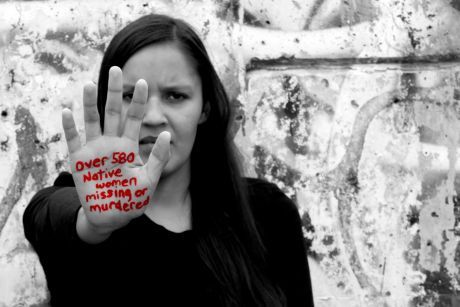News
You are here
No more stolen sisters!

February 28, 2014
The latest First Nations woman found murdered is Loretta Saunders. The young Inuk woman from Newfoundland and Labrador was a student in Halifax, writing her thesis on murdered and missing aboriginal women. She was last seen alive February 13, the day before the annual march for missing and murdered women.
In recent months three First Nations women died under suspicious circumstances in Toronto. In July Bella Laboucon-McLean, originally from the Sturgeon Lake Cree First Nation, died after falling from a lakefront condo. In April Cheyenne Fox from Sheguiandah First Nation fell from a 24-storey condo in Don Mills. In May Terra Gardner was struck and killed by a freight train. She was to have been witness in a murder case, and had complained to police about death treats. Police ruled her death was not foul play. Many of the victims of BC mass murderer Willie Pickton were First Nations women. Critics charge that if Pickton had targeted only white women, he would have been stopped much earlier.
Long before these recent deaths, First Nations communities across Canada were demanding a full-scale public inquiry into the issue of violence against Aboriginal women and girls, and the shockingly high number of murders and disappearances that go unsolved. According to the Native Women’s Association of Canada, more than 800 First Nations, Métis and Inuit women and girls have gone missing or been murdered in the past 20 years. Aboriginal women and girls represent over 10 per cent of homicides of women in Canada, despite making up only 3 per cent of the female population. While Canadian police forces solve about 85 per cent of all homicides, nearly half of those involving Aboriginal women remain unresolved.
Much of the data on this violence has been compiled by First Nations women themselves. In 2010, the group Sisters in Spirit, which has done so much to gather information, raise awareness and call for a serious inquiry, had its funding cut by the Harper Tories. The Tory government is resisting all calls for an independent inquiry. They say they are doing everything necessary, but the facts expose them. They know what an inquiry would find: that violence against First Nations women is rooted in systemic racism, sexism and poverty.
First Nations activists have had enough. Shawn Brant, an activist from Tyendinaga First Nation served notice to Stephen Harper in a letter, warning of direct action if no inquiry was called by March: “Your unwillingness to consider this first step at reconciliation is well documented and understood. It is our opinion that all diplomatic means to convince you of the need for an inquiry have failed. Further, the tears and sadness of the families left behind have not moved you to any position of compassion. We have therefore resolved that we will take whatever and further actions that are deemed necessary, to compel you to call a National Inquiry into the crisis of Murdered and Missing Aboriginal Women and Girls.” He has challenged other First Nations to step up the fight.
So far federal and provincial governments and police forces have delivered nothing but double talk and inaction. Demands for a real investigation, one directed and designed by First Nations people themselves, will only increase. The crime of violence and racism must be addressed.
The Native Women's Association of Canada has a petition demanding a national inquiry into missing and murdered aboriginal women. Download the petition here and circulate it in your classroom, workplace or neighbourhood.
Section:










